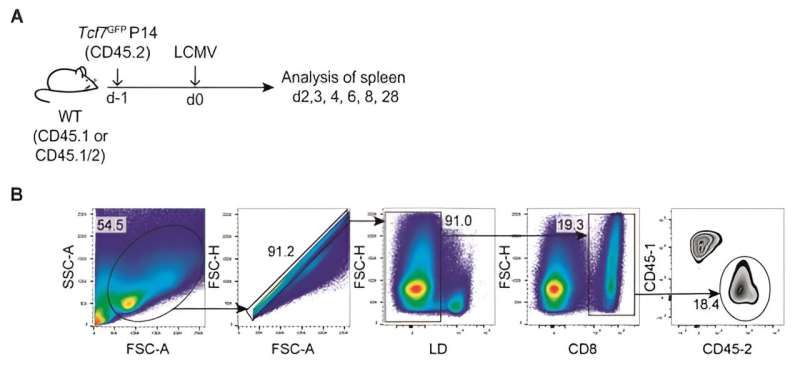December 28, 2023 feature
This article has been reviewed according to Science X's editorial process and policies. Editors have highlighted the following attributes while ensuring the content's credibility:
fact-checked
peer-reviewed publication
trusted source
proofread
Scientists solve 18-year-old mystery and find the once-elusive source of a critical T cell population

One of the more rigorous debates in immunology has centered on the origin of an enigmatic T cell population that possesses properties imparting memory and stem cell–like qualities, but facts about their genesis were so elusive that debate has raged for nearly two decades about the source of these vital immune system constituents.
Now, scientists in Switzerland have pinpointed precursors to cells known as stem-like central memory T cells—TCM cells—and tracked their transformation from precursors to active players in the immune response. The cells themselves were first identified in 2005.
Since that time, immunologists have been on the hunt for the origin of stem-like central memory T cells. Early hints suggested they were possibly a subset of CD8+ T cells, widely known interchangeably as cytotoxic or killer T cells. These immune system warriors are recognized for their defense against pathogens and relentless round-the-clock surveillance in search of cancer cells.
To be clear, the existence of TCM cells wasn't part of the years-long mystery because immunologists can quickly identify them when they see them. Stem-like central memory T cells—TCM cells—are critical to the adaptive immune system's ability to create long-lasting memories by commandeering pathogens in episodes of infection, or re-exposure, and triggering a rapid mobilization of the vital host defense. Adaptive immunity is dominated by T cells and B cells. This type of immunity develops over time as opposed to innate immunity, the non-specific immune response that reacts from birth onward.
What remained unknown was where TCM cells came from in the first place. Immunologists had long deliberated whether these stem-like T cells were actually killer Ts that acquired the properties of memory T cells. Although essential to the overall immune response, TCM cells were deeply mired in debate and steeped in controversy as immunologists around the world wrangled over the cells' source of origin.
Questions persisted: Were they relatively rare, emerging only in the face of overwhelming infection? Were they unique cells that developed in a parallel path alongside killer Ts? No one knew for sure.
Even though scientists theorize that TCM cells are also key players in the response to vaccination, filling in the blanks about the cells' genesis had remained stubbornly elusive, at least until now. New research now outlines the timing by which these cells form during the immune response.
The study, reported in Science Immunology, sheds light on these cells, and scientists at the University of Lausanne have tracked the emergence of stem cell-like central memory T cells in an animal model. The team also found that when the laboratory animals were challenged with a viral infection, TCM cells rapidly emerged. In solving the mystery of the cells' origin, scientists found that the cells are indeed derived from CD8+ T cells—killer Ts.
"In response to infection, naïve CD8+ T cells yield a large pool of short-lived terminal effector cells that eliminate infected host cells," writes Joana Gomes Silva, lead author of the new research. "In parallel, a minor population of stem cell–like central memory cells forms, which has the capacity to maintain immunity after pathogen clearance."
Silva noted that it had remained uncertain whether stem-like TCM cells arose through dedifferentiation from a subset of cytolytic T-terminal effector cells or whether priming generates stem-like cells capable of seeding the TCM. Dedifferentiation is a transient process by which cells become less specialized and return to an earlier cell state within the same lineage.
The Swiss team, which included research conducted at the Translational Data Science Facility of the Swiss Institute of Bioinformatics, also in Lausanne, found that several subtle but rapid steps led to the coveted TCM cells. In the study, Silva and colleagues described how a group of central memory precursor T cells—TpCM cells—transformed into TCM cells in laboratory mice during initial infection with the lymphocytic choriomeningitis virus.
The TpCM cells were detected early after infection, and they remained evident throughout the acute phase of the immune response. The important lesson to be derived from the research is that these precursors—TpCM cells—were predestined to become the TCM population, even though they also could transform into effector T cells when exposed to inflammatory signals. In addition, the ability to generate the precursors in response to certain vaccination models, the team found, illustrates their immune memory and suggests the key role they could play in vaccines that target them.
The team discovered that early in the immune response to infection, the precursors use the transcription factor, TCF1, which renders them predestined to become the TCM population, while other CD8+ T cells branch off into other roles in response to inflammatory cues.
"A key goal of understanding the developmental origin of TCM cells is to generate such cells by vaccination. The identification of TCM precursor cells represents an important step towards that goal," Silva concluded.
More information: Joana Gomes Silva et al, Emergence and fate of stem cell–like Tcf7 + CD8 + T cells during a primary immune response to viral infection, Science Immunology (2023). DOI: 10.1126/sciimmunol.adh3113
© 2023 Science X Network



















